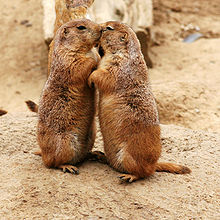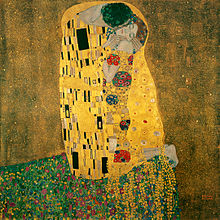Kiss: Difference between revisions
Pseudomonas (talk | contribs) m Reverted edits by Pop123445 to last version by Bluegoblin7 |
|||
| Line 77: | Line 77: | ||
== The anatomy of kissing == |
== The anatomy of kissing == |
||
A new type of kissing recently is sexual kissing. This is kissing in the nipple of the women, suckking, and also genital kissing. |
|||
Kissing is a complex [[behavior]] that requires significant muscular [[coordination (physiology)|coordination]]; in fact, a total of thirty-four to thirty-six [[muscle]]s working cooperatively. The most important [[muscle]] involved is the [[orbicularis oris muscle]], which is used to pucker the [[lip]]s and informally known as the ''kissing muscle''. The tongue can also be an extremely important part of the kiss. Lips have many nerve endings so they are sensitive to touch and bite. |
|||
== Kissing body parts == |
== Kissing body parts == |
||
Revision as of 01:32, 26 April 2008
This article needs additional citations for verification. (July 2007) |


A kiss is the touching of one person's lips to another place, which is used as an expression of affection or to show respect, and as a greeting or a farewell; kissing can be used to express romantic affection or sexual desire. The word comes from Old English cyssan "to kiss", in turn from coss "a kiss". It is generally considered one of the strongest ways to show affection.
Biology and Evolution

Anthropologists have not reached a consensus as to whether kissing is a learned or an instinctive behavior. Kissing may lead to sexual behaviors. It may be related to grooming behavior also seen between other animals, or arising as a result of mothers premasticating food for their children.[1] When mammalian mothers kiss infants, their bodies automatically recognize biological dangers to their offspring, and their bodies add resistant proteins to their milk. Kissing allows prospective mates to smell and taste each other's pheromones for biological compatibility. Women are subconsciously more attracted to men whose major histocompatibility complex portion of their genome is different from their own, leading to offspring with resistance to a greater number of diseases due to heterosis, and thus having a better chance of survival.[2] [3] [4] This explains why couples are more likely to bond if they have the right "chemistry." Also, a study by researchers at University at Albany found that women use kissing as a tool to find the right father for their children and to judge men on the quality of the first kiss that they share.
Non-human primates also exhibit kissing behavior.[5]
Other than primates there are also animals, particularly many species of birds that exhibit beak-to-beak and mouth-to-mouth behavior which is typically interpreted by observers as kissing. Dogs, cats, and other animals display licking and grooming behavior among themselves, but also towards humans or other species. This is sometimes interpreted by observers as a type of kissing, but some may see this as anthropomorphising the actions of animals.
Kissing as affection in different cultures
In modern Western culture, kissing is most commonly an expression of affection. This is unlike many parts of the world where kissing may have different meanings. Some literatures even suggest that a significant percentage of humanity do not kiss.[6] An anomaly is India, where public kissing was once quite popular, as evidenced by the common portrayal of kissing apsaras and people in motifs commonly used around palaces and temples. British rule, and a Victorian ethics system pushed public kissing into a taboo act. However, post-independence, public kissing is not uncommon in India.
In Middle Eastern countries until recent times, kissing was only considered proper when between two men, two women, or parents kissing their children. Kissing was not looked upon as a sexual expression in the Middle East.
In African, Native American and Polynesian cultures, kissing was unknown until introduced by European and Western influence.[citation needed]
With the Andamanese, kissing was only used as a sign of affection towards children and had no sexual undertones.[7]
In Eastern European countries until recent times, kissing between two men on the lips as a greeting or a farewell was as normal as the modern Western handshake [citation needed]. This custom has nearly died out due to Western influence. In the past, kissing wasn't considered sexual in Slavic and Muslim countries.
Between people of close acquaintance, a reciprocal kiss often is offered as a greeting or farewell. This kind of kiss is typically made by brief contact of puckered lips to the skin of the cheek or no contact at all, and merely performed in the air near the cheek with the cheeks touching. Such kissing is a common greeting in European and Latin American countries between a man and a woman or between two women but also by two men in parts of Europe, the Middle East and Latin America, such as Argentina. However, in most Western societies, it is often more acceptable for women to kiss each other than for men to kiss each other. People sometimes kiss children to comfort them or show affection, and vice versa. This usually takes place on the forehead or cheek.
As an expression of romantic affection or kissing involves two people pressing their lips together, usually with much more intensity, and for a considerably longer period of time. In more passionate kissing couples may open their mouths, suck on each other's lips or move their tongues into each others' mouths (see French kiss). Sexual kissing may also involve one person kissing another on various parts of the body (see Foreplay).
In some countries kissing booths exist; often at carnivals a person kisses people for money.[8][9]
Asymmetry in kissing

To avoid a clash of noses while kissing, couples often turn their faces slightly to one side, thereby orienting their heads at an angle with respect to each other. To make this position more comfortable, one member of the couple may support the other, perhaps across the lap or in an embrace—thus combining hugging with kissing. The person supporting the other may tend to take the more active role in the kiss. Writing in Nature, psychologist Onur Güntürkün observed couples kissing in public places such as airports and parks; his research demonstrated that by a 2:1 ratio the direction of turn is more frequently to the right than to the left. Güntürkün ascribed this asymmetry to a neonatal right-side preference.[10]
The anatomy of kissing
A new type of kissing recently is sexual kissing. This is kissing in the nipple of the women, suckking, and also genital kissing.
Kissing body parts

Kissing lips is common, as are other body parts such as the cheeks, forehead, neck, hand, etc. Kissing the hand is common practice when proposing marriage. Kissing body parts is common during foreplay.
Symbolic kissing
A kiss can be "blown" using actions of the hand and the mouth. One person kisses their fingers and then pretends to blow it to the other person. This is used to convey affection, usually when parting or when the partners are physically distant but can view each other. Blown kisses are also used when a person wishes to convey affection to a large crowd or audience. In written correspondence a kiss has been represented by the letter 'X' since at least 1763.[11]
Screen kiss
A screen kiss is one portrayed in a film (the equivalent act in a play is known as a stage kiss). The plot of a film or play may involve characters falling in love with each other, but the actors playing the roles might not have any personal relationship with each other whatsoever, though it has been known to happen that real-life lovers will star in films together.
Stage and or screen kissing may be performed by actually kissing, or by creating the illusion of actual contact. Methods involved in the faking of a stage/screen kiss include using one's thumbs as a barrier for the lips, and turning so that the respective audience is unable to fully see the kiss itself.
Disease transmission
Diseases which may be transmitted via kissing include mononucleosis and herpes, in which the infectious organism is present in saliva. Research indicates that contraction of HIV via kissing is extremely unlikely, however a woman has been infected with HIV by kissing in 1997; both the woman and infected man had gum disease (so transmission most likely was through the man's blood, not saliva).[12]
Notable kisses
This article contains a list of miscellaneous information. (December 2007) |
In history
- At the Diocleia festival at Megara in honour of Diocles, lover of Philolaus, a kissing contest was held in which boys would kiss a male judge, who awarded a laurel wreath to the boy he deemed the best kisser.[13]
- The Romans distinguished three types of kiss: osculum, a friendship kiss on the cheek; basium, a kiss of affection on the lips; and suavium (also known as savium), a lovers' deep kiss.
- Lord Nelson, British naval commander, famously requested "Kiss me, Hardy", as he lay dying (although they were not, as often reported, his last words).
In religion

- Muslims may kiss the Black Stone during Hajj (pilgrimage to Mecca).
- In the gospels of Matthew and Mark (Luke and John omit this) Judas betrayed Jesus with a kiss—an incongruous instance of a kiss intertwined with betrayal.
- The holy kiss or kiss of peace is a traditional part of most Christian liturgies, though usually replaced with a handshake today in Western cultures
- The pope will kiss the ground on arrival to a new country.
- Visitors to the pope traditionally kiss his foot.
- Jews will kiss the Western wall of the temple in Jerusalem, and other religious articles during prayer.
- Eastern Orthodox Christians often kiss the icons around the church as entering, they will also kiss the cross and / or the priests hand in certain other customs in the Church, such as confession or receiving a blessing.
- Catholics will kiss rosary beads as a part of prayer, or kiss their hand after making the sign of the cross.
- Hindus and Sikhs sometimes kiss the ground of a temple.
In folklore
- Both the fairytales "Sleeping Beauty" and "Snow White", and the Greek myth of Pygmalion and Galatea, a romantic kiss is used by a male to awaken or breathe life into a female.
- In modern American versions of the fairytale "Frog Prince", it is the male who is transformed into the prince from the frog kissed by the beautiful female princess.
In art

- Works entitled The Kiss were painted by Gustav Klimt, Francesco Hayez and Edvard Munch.
- Auguste Rodin created the sculpture The Kiss (Le Baiser).
- The Kiss (1931) is a photograph by Man Ray.
- Andy Warhol made an avant-garde film, the kiss, closeups of couples kissing.
In film
- The Kiss, an 1896 short film, features the first known screen kiss, a forty-seven second recreation of a stage kiss from the musical The Widow Jones. The movie was considered scandalous at the time of its release but has since entered film history as one of the most memorable early films.
- The Kid is a 1921 film, in which a tramp, Charlie Chaplin, kisses a child, Jackie Coogan. This scene is the first in film history in which a man kisses a boy on the mouth.
- Chaplin also employed the "insulting kiss" in at least one film, a device that Bugs Bunny would later copy, countless times, to distract Elmer Fudd and other threatening characters.
- In the 1955 film Lady and the Tramp, the canine characters Lady and Tramp unexpectedly kiss while simultaneously eating a spaghetti noodle from opposite ends, their lips meeting in the middle. Homages to and parodies of this scene have appeared in several movies, including Hot Shots! Part Deux.
- In The Princess Bride, the narrator comments on Westley and Buttercup's kiss: "Since the invention of the kiss, there have been five kisses that were rated the most passionate, the most pure. This one left them all behind."
- In the 1989 animated disney film, The Little Mermaid, Sebastian sings "Kiss the Girl" to Ariel and Prince Eric in an attempt to break the spell that was cast upon her which prevented her from speaking.
- In The Godfather: Part II, Michael Corleone gives, in Havana, an unnaturally aggressive kiss on the mouth to his brother Fredo, effectively telling him that he is disowned from the family because he betrayed its interests. Michael has Fredo killed.
In theatre
- In William Shakespeare's play Romeo and Juliet, Romeo first greets Juliet with an exchange of metaphors stating that he wants to kiss her. Romeo starts by comparing Juliet to a shrine that his "unworthiest hands" are defiling by touching, and his lips to "two blushing pilgrims" who want to make it up to her. Juliet retorts that Romeo, as a pilgrim, should not degrade his hands as "hand-to-hand is holy palmers kiss," meaning they Juliet (saint) and Romeo (pilgrim) can "kiss" hand to hand. Romeo asks why pilgrims and saints can't use their lips, and Juliet responds that saints must use them in prayer. Romeo then gets his kisses by saying that their lips should do what praying hands do (come together). Juliet gives in, but playing the saint, she will not move.
In photography
- Alfred Eisenstaedt's 1945 LIFE magazine photograph of a sailor stamping a masterly kiss on a nurse in New York City's Times Square was taken Aug. 14, 1945, V-J Day. This photo is considered one of Times Square's most iconic photographs[14]. In 2007, a Houston forensics expert verified the identity of the sailor as Glenn McDuffie, who had claimed to be the individual in the photo for many years.[15]
- The French photographer Robert Doisneau shot a couple kissing by the Hotel de Ville (Paris) in 1950. The photo, later called "The Kiss," is now considered a classic, a fact one couple alleging to be the subjects of the photo attempted to exploit in their unsuccessful 1990s lawsuit against the photographer.
- Tanya Chalkin's Kiss, a black-and-white photo of two young women embracing, has become something of a pop culture icon in recent years.
World Records
- The longest recorded kiss took place in New York City on December 5, 2001, between Louisa Almedovar and Rich Langley. It lasted 30 hours, 59 minutes and 27 seconds.[16]
- On September 1, 2007, 6980 couples kissed for 10 seconds in Tuzla, Bosnia erasing the previous Guinness World kissing Records of the Philippines and Hungary (for synchronised osculation in 2004 with 5327 Filipino couples, overtaken by Hungary in 2005 with 5875 couples; Filipinos came back in February this year with 6124 couples but the Hungarians responded in June with 6613 couples). The record now awaits official certification.[17]
See also
- Air kiss
- Cheek kissing
- Eskimo kiss
- French kiss
- Hand-kissing
- Hand shaking
- Holy kiss
- Hugs
- Hugs and Kisses
- Judas Kiss
- Kissing Games
- Kissing Traditions
- Making out
Notes
- ^ Premastication - Langmaker
- ^ Santos, PS (2005). "New evidence that the MHC influences odor perception in humans: a study with 58 Southern Brazilian students". Hormones & Behavior. 47: 384–388.
{{cite journal}}: Unknown parameter|coauthors=ignored (|author=suggested) (help) - ^ Wedekind, C. (1995). "MHC-dependent mate preferences in humans". Proceedings: Biological Sciences. 260 (1359): 245–249.
{{cite journal}}: Unknown parameter|coauthors=ignored (|author=suggested) (help) - ^ Fiore, Kristina (October 2, 2006). "Why do humans kiss?". Scienceline.
{{cite web}}: Check date values in:|date=(help) - ^ "How animals kiss and make up". BBC News. October 13, 2003.
{{cite news}}: Check date values in:|date=(help) - ^ Affairs of the Lips: Why We Kiss: Scientific American
- ^ Chapter: 9: A Traditional Society
- ^ Pasco: A fundraiser in the buff
- ^ CTV.ca | Alberta's bear-kissing booth back in business
- ^ Onur Güntürkün. "Human behaviour: Adult persistence of head-turning asymmetry". Retrieved 2007-10-30.
A neonatal right-side preference makes a surprising romantic reappearance later in life.
- ^ "Oxford English Dictionary - X". Oxford University press. 1999. Retrieved 2007-02-01.
- ^ Case of H.I.V. Transmission Is First to Be Linked to Kiss - New York Times
- ^ Theocritus, Idyll 12:30
- ^ Daily Mail, 13 August 2007, Accessed 7 October 2007
- ^ suntimes.com
- ^ The International World Record Breakers' Club: The World Record for the Longest Kiss
- ^ SMH, Record breakers: Ready, set - now pucker up for Bosnia
